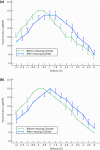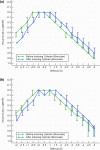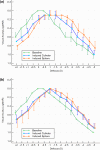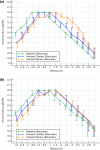Inducing cylindrical and spherical defocus after implantation with new generation intraocular lenses improves intermediate and near visual acuity
- PMID: 39738428
- PMCID: PMC11686359
- DOI: 10.1038/s41598-024-83387-3
Inducing cylindrical and spherical defocus after implantation with new generation intraocular lenses improves intermediate and near visual acuity
Abstract
An induced cylinder and spherical power after implantation with an extended depth of focus (EDOF) and enhanced monofocal intraocular lens (IOL) could improve distance, intermediate (60 cm) and near (40 cm) visual acuity (VA). In this prospective study, forty eyes with Eyhance EDOF IOL (Johnson and Johnson, USA) and 40 eyes with Vivity EDOF IOL (Alcon Laboratories Inc. USA) were included. Induced cylinder (applied to non-dominant eye) in steps of + 0.25D were used and then VA was measured monocularly (only non-dominant eye). Similarly, induced sphere (applied to non-dominant eye) in steps of + 0.25D were used and then VA was measured monocularly (only non-dominant eye). The above methods were repeated for the dominant eye as well. Then, binocular defocus curve for each patient was obtained by inducing optimal sphere and cylinder (one at a time in front of the non-dominant eye only). In both IOL groups, induced cylinder and sphere independently led to significant improvement in near and distance vision (p < 0.05). Induced sphere binocularly caused a greater decrease (~ 0.1 LogMAR) in distance VA compared to induced cylinder but this was not clinically significant. Most patients accepted an induced cylinder of +1.0 to +1.5D in both IOL groups. Induced cylinder and sphere caused a favourable improvement in near and intermediate VA after surgery in both IOL groups without a significant drop in distance VA.
Keywords: Cataract; Cylinder; Defocus; Eyhance; Monovision; Vivity.
© 2024. The Author(s).
Conflict of interest statement
Declarations. Competing interests: The authors declare no competing interests.
Figures




Similar articles
-
Visual outcomes following bilateral implantation of a non-diffractive extended depth of focus toric intraocular lens using a mini-monovision approach.Int Ophthalmol. 2024 Jul 24;44(1):334. doi: 10.1007/s10792-024-03247-x. Int Ophthalmol. 2024. PMID: 39046597
-
Outcome of a Mix-and-Match Approach with a Monofocal Aspherical and a Bifocal Extended Depth-of-Focus Intraocular Lens to Achieve Extended Monovision in Cataract Patients.Klin Monbl Augenheilkd. 2025 Apr;242(4):372-378. doi: 10.1055/a-2479-9041. Epub 2025 Jan 13. Klin Monbl Augenheilkd. 2025. PMID: 39805287 English.
-
Reading Performance Following Contralateral Implantation of an Extended Depth of Focus (EDOF) IOL and a Hybrid EDOF Multifocal IOL.J Refract Surg. 2024 Nov;40(11):e778-e782. doi: 10.3928/1081597X-20240909-01. Epub 2024 Nov 1. J Refract Surg. 2024. PMID: 39530986
-
Using adaptive optics to optimize the spherical aberration of eyes implanted with EDOF and enhanced monofocal intraocular lenses.J Cataract Refract Surg. 2024 Jan 1;50(1):30-36. doi: 10.1097/j.jcrs.0000000000001315. J Cataract Refract Surg. 2024. PMID: 37732726
-
Visual outcomes of non-diffractive extended-depth-of-focus and enhanced monofocal intraocular lenses: A case-control study.Eur J Ophthalmol. 2023 Jan;33(1):262-268. doi: 10.1177/11206721221125004. Epub 2022 Sep 4. Eur J Ophthalmol. 2023. PMID: 36062601
References
-
- Rocha, K. M., Vabre, L., Chateau, N. & Krueger, R. R. Expanding depth of focus by modifying higher-order aberrations induced by an adaptive optics visual simulator. J. Cataract. Refract. Surg.35, 1885–1892 (2009). - PubMed
-
- Huber, C. Planned myopic astigmatism as a substitute for accommodation in pseudophakia. J. Am. Intraocul. Implant. Soc.7, 244–249 (1981). - PubMed
-
- Sawusch, M. R. & Guyton, D. L. Optimal astigmatism to enhance depth of focus after cataract surgery. Ophthalmology98, 1025–1029 (1991). - PubMed
-
- Nagpal, K. M., Desai, C., Trivedi, R. H. & Vasavada, A. R. Is pseudophakic astigmatism a desirable goal? Indian J. Ophthalmol.48, 213–216 (2000). - PubMed
-
- Savage, H., Rothstein, M., Davuluri, G., El Ghormli, L. & Zaetta, D. M. Myopic astigmatism and presbyopia trial. Am. J. Ophthalmol.135, 628–632 (2003). - PubMed
MeSH terms
LinkOut - more resources
Full Text Sources

